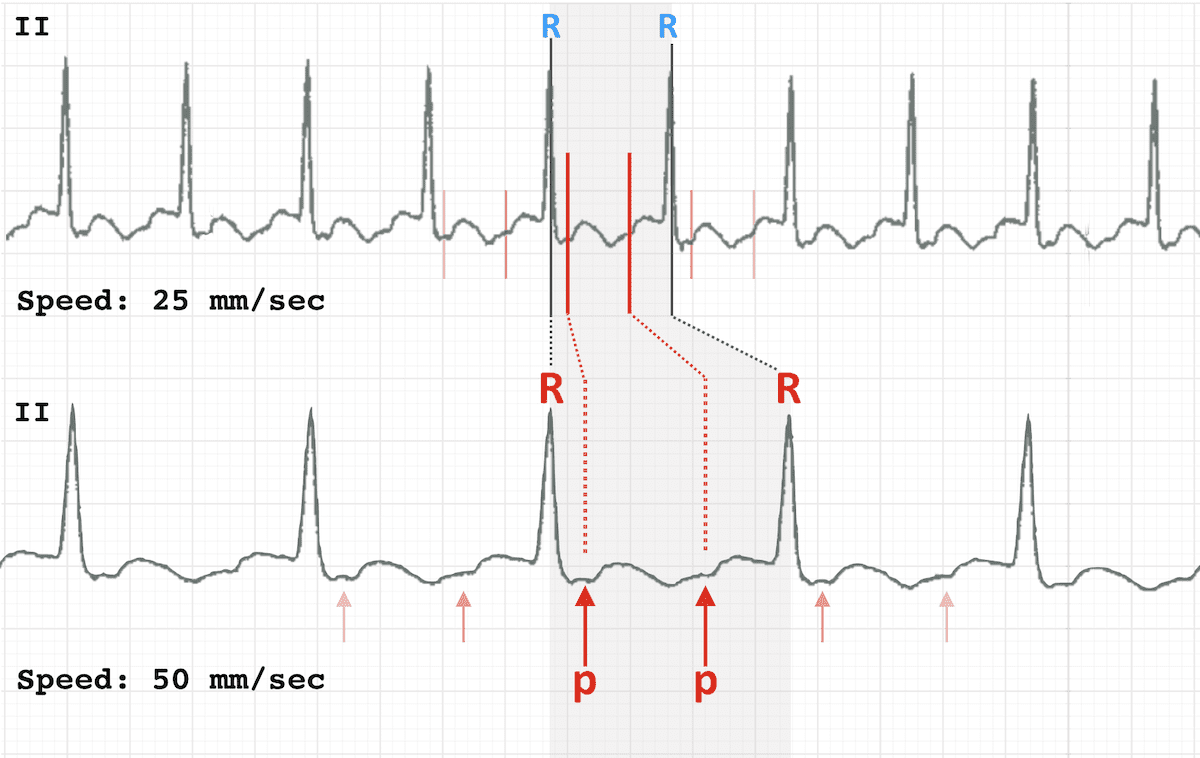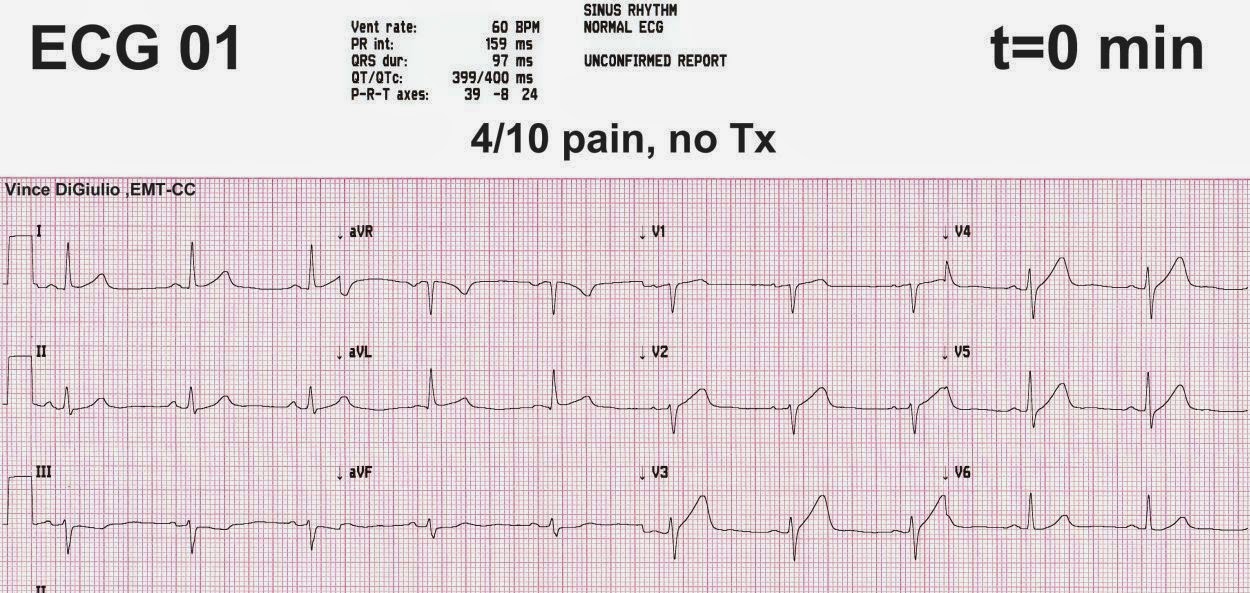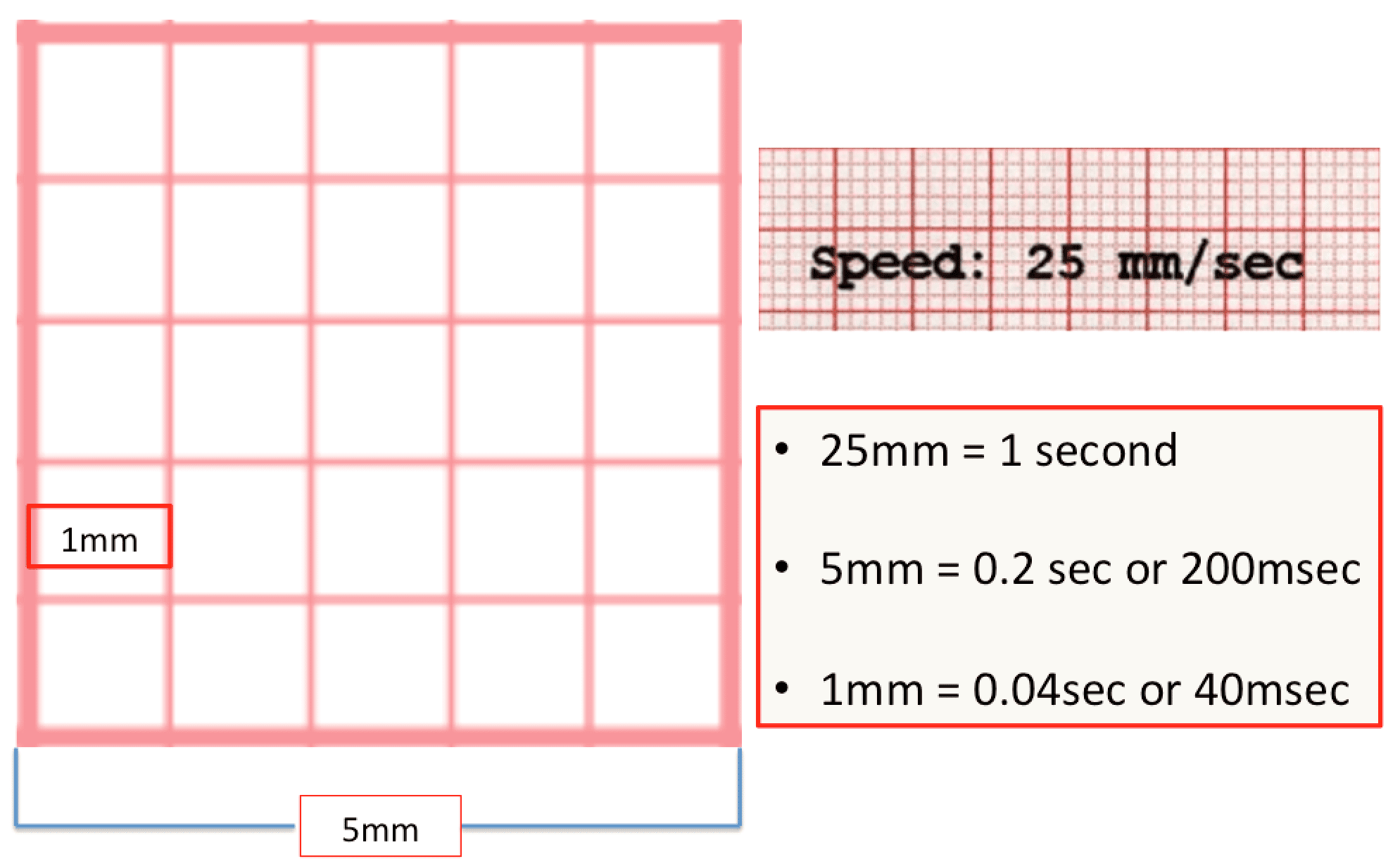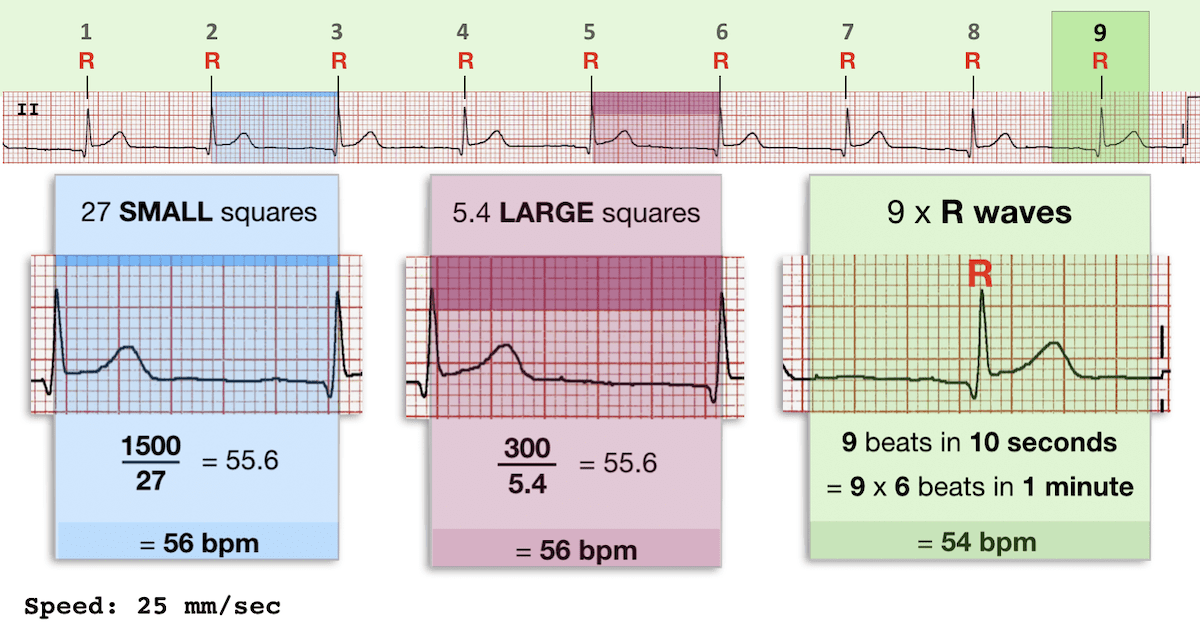Que Es Un Electrocardiograma Interpretación Y Significado

Que Es Un Electrocardiograma Interpretación Y Significado
Set at 25 mm/s. Every 5 large squares equals 1 second. Standard paper: large square = 5 mm (0.2 seconds). small square = 1 mm (0.04 seconds). Calibration: 1 millivolt of electrical activity moves stylus 1 cm on ECG paper 12-lead ECG A standard 12-lead ECG utilises 10 leads to offer 12 different 'views' of the heart.

ECG Rate Interpretation • LITFL Medical Blog • ECG Library Basics
The standard ECG paper speed is 25 mm/sec and therefore: 1 mm (1 'small square') = 0.04 seconds. 5 mm (1 'large square') = 0.2 seconds. On the vertical axis,10 mm (10 'small squares') is equal to 1 mV when standard calibration is used. Please refer to the ECG tracing below to familiarize yourself with the waves of the ECG and how.

Die EKGAbleitungen Elektroden, Extremitätenableitungen, Brustwandableitungen, 12KanalEKG
The heart rate can be calculated, approximately, according to the number of 0.20 s spaces (which are the spaces separated by thick lines on the ECG paper when the recording paper speed is 25 mm/s) occurring in an RR cycle . Another method is to count the RR cycles occurring in 6 s and multiply this number by 10. P wave

How To Calculate Heart Rate From Ecg
The ECG paper speed is ordinarily 25 mm/sec. As a result, each 1 mm (small) horizontal box corresponds to 0.04 sec (40 ms), with heavier lines forming larger boxes that include five small boxes and hence represent 0.20 sec (200 ms) intervals. On occasion, the paper speed is increased to 50 mm/sec to better define waveforms.

Dr. Smith's ECG Blog Incredible Case Demonstrating the Value of Frequent Serial ECGs
At 25 mm/s paper speed, the heart rate is equal to 300 divided by the number of large boxes between two beats (for simplicity, use the distance between two R waves). As seen in Figure 2, there are 5 large boxes between two R waves, hence the heart rate is: 300/5 = 60 beats/min

Elsie Circuit What Is A 12 Lead Ecg
The electrocardiogram is recorded on to standard paper travelling at a rate of 25 mm/s. The paper is divided into large squares, each measuring 5 mm wide and equivalent to 0.2 s. Each large square is five small squares in width, and each small square is 1 mm wide and equivalent to 0.04 s.

ECG Basics R.E.B.E.L. EM Emergency Medicine Blog
An electrode is a conductive pad that is attached to the skin and enables the recording of electrical currents. An ECG lead is a graphical description of the electrical activity of the heart and it is created by analyzing several electrodes.

Wählen Anfrage Schiffbau vorhofflimmern mit uhr erkennen Pelagisch Grenze Picken
Figure 1. ECG showing sinus tachycardia. Paper speed 25 mm/s. Calculate the heart rate by dividing 300 by the number of large boxes between R-waves. There are approximately 3 large boxes between the R-waves; 300/3 equals 100 beats per minute.

Dr. Smith's ECG Blog A 65 year old with chest pain, ECG recorded at 50 mm/sec
A typical ECG tracing is shown to the right. The different waves that comprise the ECG represent the sequence of depolarization and repolarization of the atria and ventricles. The ECG is recorded at a speed of 25 mm/sec (5 large squares/sec), and the voltages are calibrated so that 1 mV = 10 mm (2 large squares) in the vertical axis.

Image Quiz Common & Easily Mistaken ECG Rhythms Clinician's Brief
How to read a rhythm strip You can apply the 6-stage approach to help you interpret ECG rhythm strips. Select each heading to find out more. Stage 1 - is there any electrical activity? Stage 2 - what is the ventricular (QRS) rate? Stage 3 - is the QRS rhythm regular or irregular? Stage 4 - is the width of the QRS complex normal (narrow)

Calculation of heart rate
Figure 1. Electrode positions on an ECG (EKG). When electrical activity (or depolarisation) travels towards a lead, the deflection is net positive. When the activity travels away from the lead the deflection is net negative. If it is at 90 degrees then the complex is 'isoelectric' i.e. the R and S wave are the same size.

Cara Menghitung Heart Rate EKG Nerslicious
On a standard EKG the paper speed is 25 mm/s. Therefore, each 1 mm square on the horizontal axis equals 0.04 s, and each large square, 0.20 s. Electrocardiogram paper measures: Vertical: 1 mm = 0.1 mV. Horizontal: 1 mm = 0.04 s. These are the values used on a standard EKG.
Który przesuw zapisu EKG jest lepszy — 25 czy 50 mm/s? Baranowski Choroby Serca i Naczyń
Electrocardiography is an important diagnostic tool in cardiology. External electrodes are used to measure the electrical conduction signals of the heart and record them as lines on graph paper (i.e., an electrocardiogram; ECG).

Der Sinusrhythmus Physiologie, EKGKriterien und klinische Bedeutung EKG & ECHO
Interpreting the ECG is a task that requires an underpinning knowledge of the way the ECG is organised, what is being displayed and what the normal ranges and values of the various waveforms, intervals and segments should be.

ECG Rate Interpretation • LITFL Medical Blog • ECG Library Basics
To achieve this goal, you should perform an ECG of a 6-second duration. 6 seconds equals 30 big boxes (5 mm each), as you will see in the following equation: (6 s × 25 mm/s) / 5 mm = 30 big boxes. Now, you can use this knowledge to get the estimation of your patient's heart rate: Count the number of R waves in 6 seconds or 30 boxes on the ECG.

Representative 12lead surface ECG (25 mm/s, 10 mm/mV) from a patient...
In a standard EKG, the speed is 25 mm/s and the amplitude 1 mV by 10 mm (read EKG paper ). For that, we must check the speed at which the paper moves and the amplitude values-on a standard EKG, speed is 25 mm per second and the amplitude value, 1 mV per 10 mm (read EKG paper ).